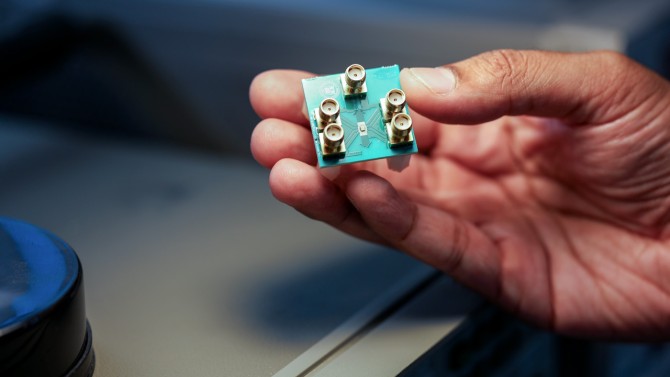Microwave Neural Network
Cornell researchers have developed a low-power microchip they call a “microwave brain,” the first processor to compute on both ultrafast data signals and wireless communication signals by harnessing the physics of microwaves.
Detailed Aug. 14 in Nature Electronics, the processor is the first true microwave neural network and is fully integrated on a silicon microchip. It performs real-time frequency domain computation for tasks like radio signal decoding, radar target tracking and digital data processing, all while consuming less than 200 milliwatts of power.
“Because it’s able to distort in a programmable way across a wide band of frequencies instantaneously, it can be repurposed for several computing tasks,” said lead author Bal Govind, M.S. ’24, a doctoral student who conducted the research with Maxwell Anderson ’20, M.S. ’24, also a doctoral student. “It bypasses a large number of signal processing steps that digital computers normally have to do.”

That capability is enabled by the chip’s design as a neural network, a computer system modeled on the brain, using interconnected modes produced in tunable waveguides. This allows it to recognize patterns and learn from data. But unlike traditional neural networks that rely on digital operations and step-by-step instructions timed by a clock, this network uses analog, nonlinear behavior in the microwave regime, allowing it to handle data streams in the tens of gigahertz – much faster than most digital chips.
“Bal threw away a lot of conventional circuit design to achieve this,” said Alyssa Apsel, the Ellis L. Phillips Sr. Director of the School of Electrical and Computer Engineering, who was co-senior author with Peter McMahon, associate professor of applied and engineering physics. “Instead of trying to mimic the structure of digital neural networks exactly, he created something that looks more like a controlled mush of frequency behaviors that can ultimately give you high-performance computation.”
The chip can perform both low-level logic functions and complex tasks like identifying bit sequences or counting binary values in high-speed data. It achieved at or above 88% accuracy on multiple classification tasks involving wireless signal types, comparable to digital neural networks but with a fraction of the power and size.
“In traditional digital systems, as tasks get more complex, you need more circuitry, more power and more error correction to maintain accuracy,” Govind said. “But with our probabilistic approach, we’re able to maintain high accuracy on both simple and complex computations, without that added overhead.”
The chip’s extreme sensitivity to inputs makes it well-suited for hardware security applications like sensing anomalies in wireless communications across multiple bands of microwave frequencies, according to the researchers.
“We also think that if we reduce the power consumption more, we can deploy it to applications like edge computing. You could deploy it on a smartwatch or a cellphone and build native models on your smart device instead of having to depend on a cloud server for everything.” - Alyssa Apsel
Though the chip is still experimental, the researchers are optimistic about its scalability. They are experimenting with ways to improve its accuracy and integrate it into existing microwave and digital processing platforms.
